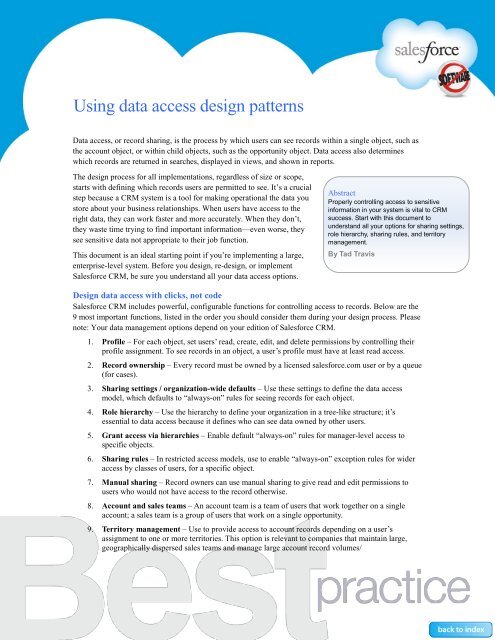Best Practices for Implementing Salesforce CRM - Cloud Experts
Best Practices for Implementing Salesforce CRM - Cloud Experts
Best Practices for Implementing Salesforce CRM - Cloud Experts
Create successful ePaper yourself
Turn your PDF publications into a flip-book with our unique Google optimized e-Paper software.
Using data access design patternsData access, or record sharing, is the process by which users can see records within a single object, such asthe account object, or within child objects, such as the opportunity object. Data access also determineswhich records are returned in searches, displayed in views, and shown in reports.The design process <strong>for</strong> all implementations, regardless of size or scope,starts with defining which records users are permitted to see. It’s a crucialstep because a <strong>CRM</strong> system is a tool <strong>for</strong> making operational the data youstore about your business relationships. When users have access to theright data, they can work faster and more accurately. When they don’t,they waste time trying to find important in<strong>for</strong>mation—even worse, theysee sensitive data not appropriate to their job function.This document is an ideal starting point if you’re implementing a large,enterprise-level system. Be<strong>for</strong>e you design, re-design, or implementSales<strong>for</strong>ce <strong>CRM</strong>, be sure you understand all your data access options.AbstractProperly controlling access to sensitivein<strong>for</strong>mation in your system is vital to <strong>CRM</strong>success. Start with this document tounderstand all your options <strong>for</strong> sharing settings,role hierarchy, sharing rules, and territorymanagement.By Tad TravisDesign data access with clicks, not codeSales<strong>for</strong>ce <strong>CRM</strong> includes powerful, configurable functions <strong>for</strong> controlling access to records. Below are the9 most important functions, listed in the order you should consider them during your design process. Pleasenote: Your data management options depend on your edition of Sales<strong>for</strong>ce <strong>CRM</strong>.1. Profile – For each object, set users’ read, create, edit, and delete permissions by controlling theirprofile assignment. To see records in an object, a user’s profile must have at least read access.2. Record ownership – Every record must be owned by a licensed sales<strong>for</strong>ce.com user or by a queue(<strong>for</strong> cases).3. Sharing settings / organization-wide defaults – Use these settings to define the data accessmodel, which defaults to “always-on” rules <strong>for</strong> seeing records <strong>for</strong> each object.4. Role hierarchy – Use the hierarchy to define your organization in a tree-like structure; it’sessential to data access because it defines who can see data owned by other users.5. Grant access via hierarchies – Enable default “always-on” rules <strong>for</strong> manager-level access tospecific objects.6. Sharing rules – In restricted access models, use to enable “always-on” exception rules <strong>for</strong> wideraccess by classes of users, <strong>for</strong> a specific object.7. Manual sharing – Record owners can use manual sharing to give read and edit permissions tousers who would not have access to the record otherwise.8. Account and sales teams – An account team is a team of users that work together on a singleaccount; a sales team is a group of users that work on a single opportunity.9. Territory management – Use to provide access to account records depending on a user’sassignment to one or more territories. This option is relevant to companies that maintain large,geographically dispersed sales teams and manage large account record volumes/
















